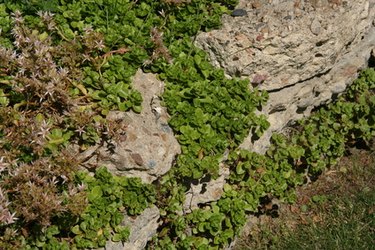Things You'll Need
Soil testing kit
Garden fork
Lime or peat moss
Soaker hose

The creeping fig (Ficus pumila) is an aggressive climber that produces delicate green leaves, commonly used in topiaries, hanging baskets and ground covers. This evergreen plant averages 40 feet at maturity, but three and four story heights are not unheard of. Creeping fig prefers planting in the rich, well-drained soils of USDA hardiness zones 8 through 11. Full sun to partial shade is required for healthy leaf coloring, as well as a soil pH between 6.1 and 7.8.
Step 1
Test your soil prior to planting. Use a soil testing kit purchased from a garden center to determine the pH.
Video of the Day
Step 2
Loosen the soil with a garden fork. Amend with lime if the pH is below 6.1 or peat moss if the soil pH is above 7.8. Apply the amendment per label instructions.
Step 3
Dig holes for the creeping fig twice the width of the root balls. The depth should equal that of the root balls. Space the holes 18 to 24 inches apart.
Step 4
Remove the creeping fig plants from their nursery containers. Set one creeping fig plant in each hole. Backfill the holes, patting the soil afterward to remove air pockets.
Step 5
Water the creeping fig plants immediately after planting using a soaker hose. Water the creeping fig plants once a week in lieu of rain, maintaining moist soil at a depth of 1 inch at all times.
Tip
Once established, creeping fig will only require watering during droughts.
Warning
Do not over-water the creeping fig. Standing water promotes root rot and plant disease. If the soil feels moist at a 1-inch depth, do not add more water. Instead, check back in a few days.
Video of the Day